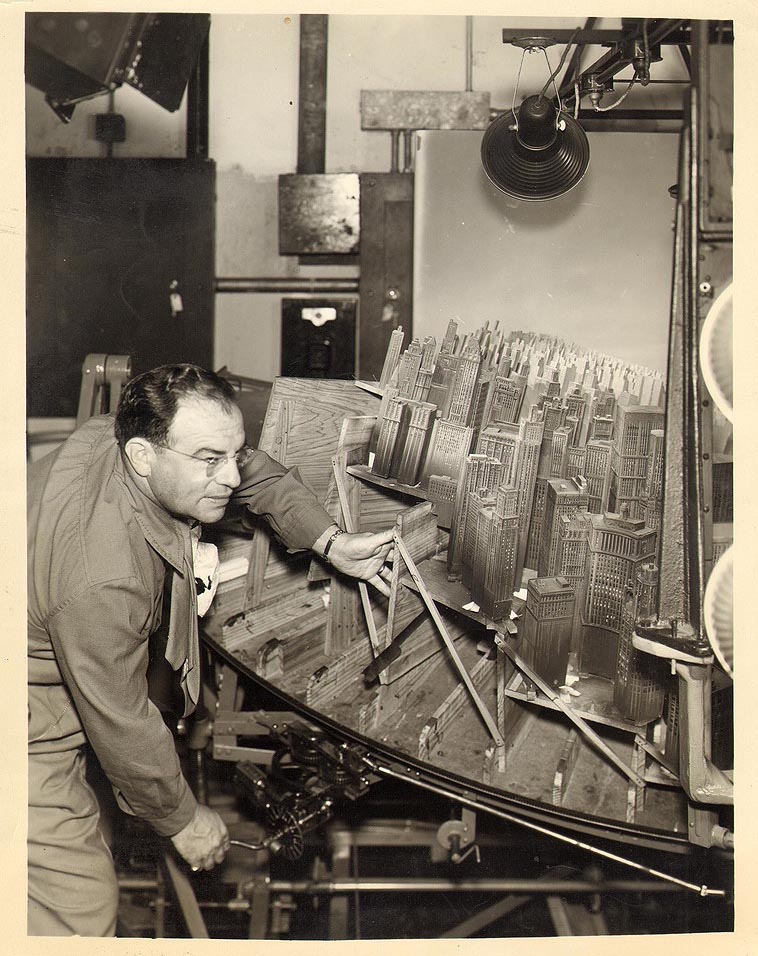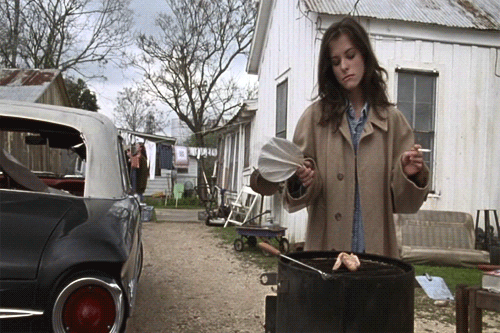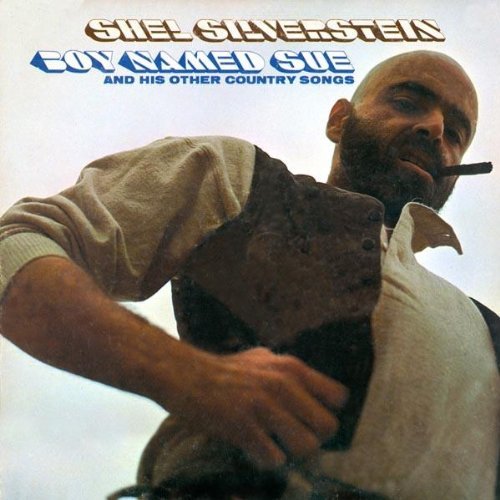Links and write-ups about beautiful things from around the web!
-
Fleischer Popeye 3d Backgrounds

Dave Fleischer of Fleischer Studios demos the distorted-architecture-on-a-turntable that his studio pioneered for creating compelling 3D backgrounds in their animated shorts. You can see it in motion in a number of their Popeye cartoons (like Popeye Meets Ali Baba and the Forty Thieves) or in their originals like Mr. Bug Goes to Town (PS: check out that awesome title card typography!)
If you happen to be in L.A. this week, you can catch some classic Fleischer shorts in pristine 35mm prints as part of Jerry Beck’s animation series at the Cinefamily. Do it!
(Via Cartoon Brew)
-
“There’ll Always Be a Place for Me at the Dairy Queen”

As I said before, Parker Posey grilling a single chicken wing is one of my favorite funnysad scenes committed to film. And now I’ve committed it to an animated GIF.
-
Salman Rushdie on Ai Weiwi
The lives of artists are more fragile than their creations. The poet Ovid was exiled by Augustus to a little hell-hole on the Black Sea called Tomis, but his poetry has outlasted the Roman Empire. Osip Mandelstam died in a Stalinist work camp, but his poetry has outlived the Soviet Union. Federico García Lorca was killed by the thugs of Spain’s Generalissimo Francisco Franco, but his poetry has survived that tyrannical regime.
We can perhaps bet on art to win over tyrants. It is the world’s artists, particularly those courageous enough to stand up against authoritarianism, for whom we need to be concerned, and for whose safety we must fight.
From Salman Rushdie’s op-ed “Dangerous Arts” in today’s New York Times, on Ai Weiwei’s arrest and detention by Chinese authorities, a matter of human rights urgency. -
Bit.Trip.Runner Blind Gamer
Mechanical engineering student Terry Garret plays through a few levels of Bit.Trip.Runner, one of my favorite games of the past year. It’s a very challenging game, with simple actions but difficult timings that are set to fun 8-music and sound effects.
Oh, by the way, Terry is completely blind.
-
Arthouse Fissures
With the Austin Museum of Art shuttering their downtown location, the city’s crackdown on home/studio spaces on the east side, the House voting to gut the funding for the Texas Commission for the Arts, and the recent news that Art Lies is ceasing publication, what could make this a bleaker month for central Texas art?
Arthouse, the 100-year-old Austin-based organization I’ve been proud to support since the days when it was still called the Texas Fine Arts Association, is beginning to show signs of fracture, despite their beautiful new façade. You can get the bigger story over at Austin360 if you’ve missed it in the news, but to summarize: exhibited art has been mishandled and censored, their admired and successful curator was fired abruptly (possibly after having written a letter of concern to the director about the above-mentioned mishandling), and some of their prominent board members and staff members have resigned in protest. There’s also a growing collective voice of concern by the artists who were to be contributing work to the upcoming 5×7 fundraising show (myself included). So far, apart from short responses directly to inquiring reporters, I don’t believe that Arthouse has issued a statement on the matter, which isn’t especially good PR in my humble opinion.
Eric Zimmerman has a nice summary of the concerns on his cablegram blog:
No one would argue against a new building, or at very least a renovation. But when you dump truckloads of cash into a designer building and neglect to budget for a curator, the person who puts the actual art in the Arthouse, there seems to be some serious priority issues. I said it before, a building is nice and all, but what you show in that building is where the rubber meets the road. I’d love to see art organizations forgo the starchitect buldings and put money into paying artists, curators, and their staff instead.
For the curatorial angle (or perhaps, the “lack of curator”), you might be interested in Wendy Vogel’s take over on …might be good.
Here’s to hoping that Arthouse can steer itself back on track as the leading space for contemporary art in Austin.
-
Little Nemo Turns 100
The principal factor in my success has been an absolute desire to draw constantly. I never decided to be an artist. Simply, I could not stop myself from drawing. I drew for my own pleasure. I never wanted to know whether or not someone liked my drawings. I drew on walls, the school blackboard, old bits of paper, the walls of barns. Today I’m still as fond of drawing as when I was a kid — and that’s a long time ago… The incomparable Winsor McCay, quoted in a Los Angeles Times blog post that points out that this is the 100th anniversary of McCay’s short film Little Nemo. If you’ve never seen his animated shorts — they’re among the first examples of the medium, and yet still technically brilliant — you should hit up the YouTube and get started with Nemo…
-
A Boy Named Jean

Shel Silverstein looking characteristically intimidating on his 1969 country album, Boy Named Sue and His Other Country Songs (yes, yes, he wrote that song, but did you know that it was originally inspired by Shel’s friend saddled with a girly name, Jean Shepherd?)
-
Forget the Firetruck: Future Firefighters May Use Ghostbusters-Like Electric Backpacks
From Discover:
This futuristic method is based on a centuries-old observation that electric fields can do funny things (videos) to flames, making them sputter and even snuffing them out.
The researchers’ early-stage prototype consists of a 600-watt amplifier hooked up to a electric beam-shooting wand, according to their presentation at the American Chemical Society meeting earlier this week. In tests, they were able to quickly zap out flames over a foot high.
I look forward to the day when I can dial 911 and get the ArcAttack guys over to put out the blaze!
-
Videogames Are Liquid Architecture
If architecture is frozen music, then a videogame is liquid architecture. Journalist and critic Steven Poole, author of Trigger Happy, quoted in an counter-point article by Michael Mirasol posted on Roger Ebert’s blog, Why video games are indeed Art.
-
Poka-yoke
Poka-yoke (ポカヨケ) is a Japanese term that means “fail-safing” or “mistake-proofing”. A poka-yoke is any mechanism in a lean manufacturing process that helps an equipment operator avoid (yokeru) mistakes (poka). Its purpose is to eliminate product defects by preventing, correcting, or drawing attention to human errors as they occur.
Not just handy for manufacturing processes, this idea applies very easily to any kind of designed object. How can we make what we design not only easy to use, but as difficult as possible to mis-use? (It’s worth noting that this principle was originally described as baka-yoke, i.e. idiot-proof, unfairly placing the blame on the user instead of the design)
